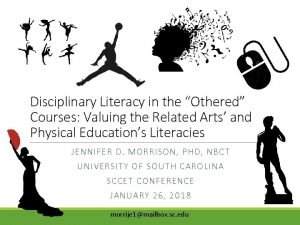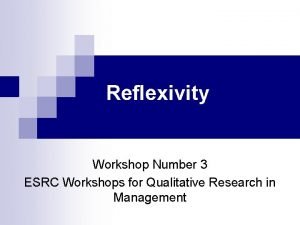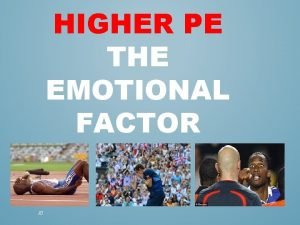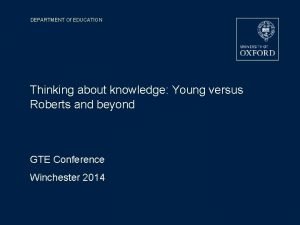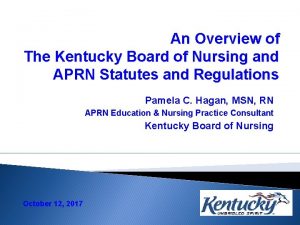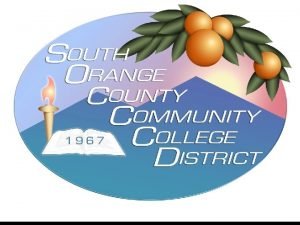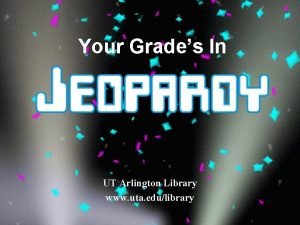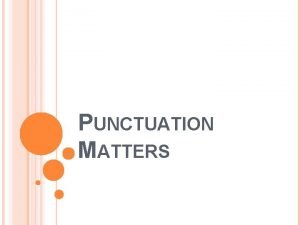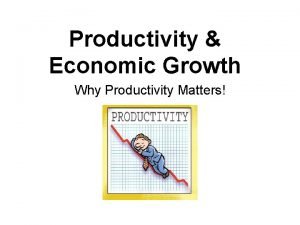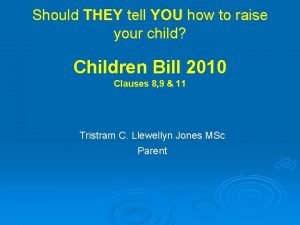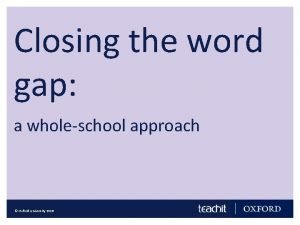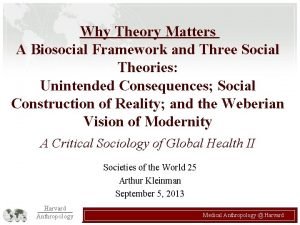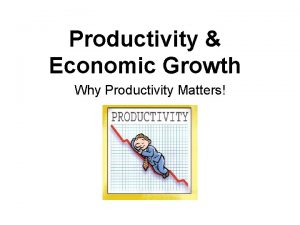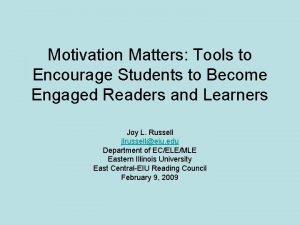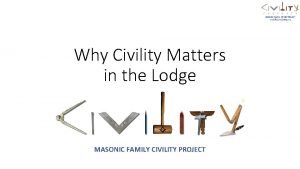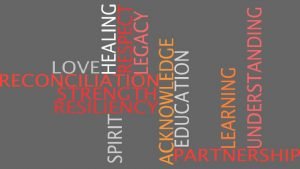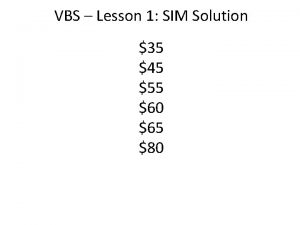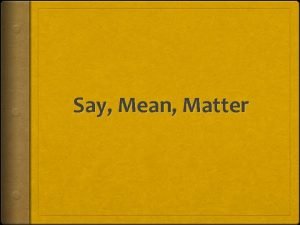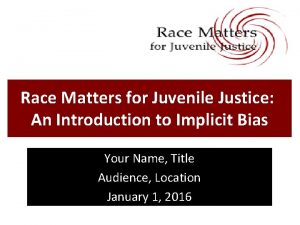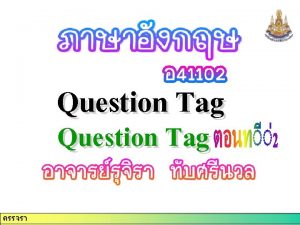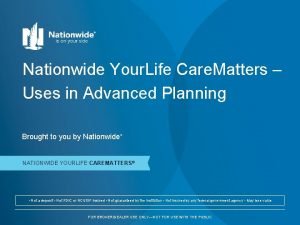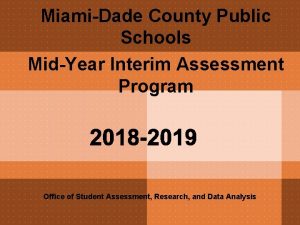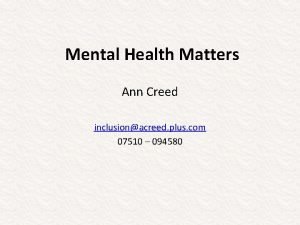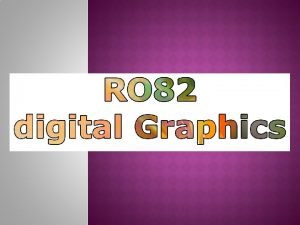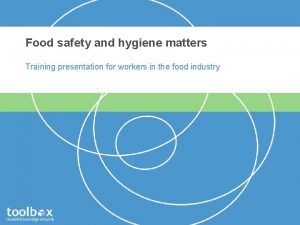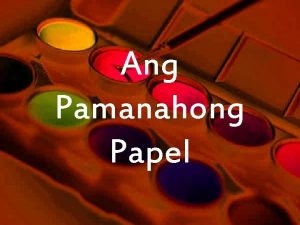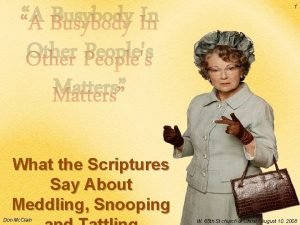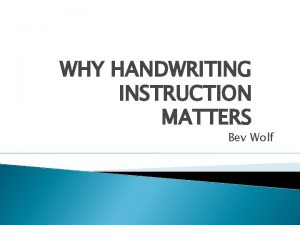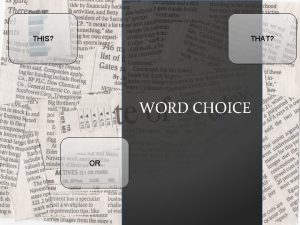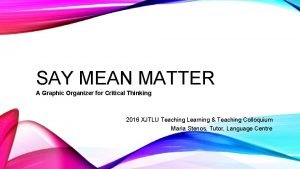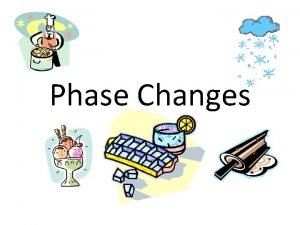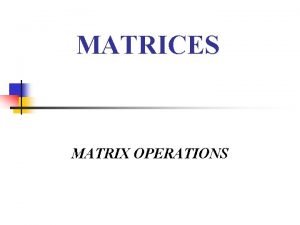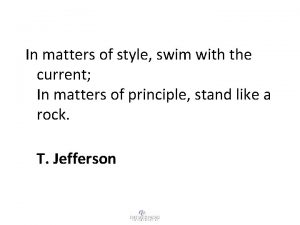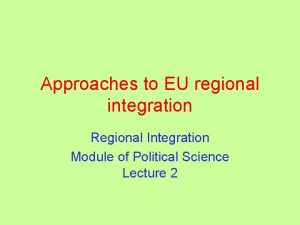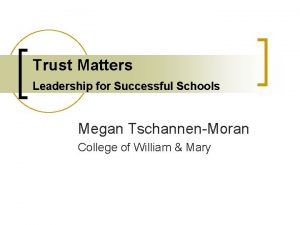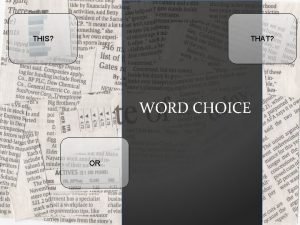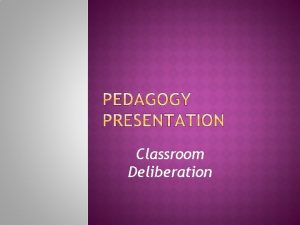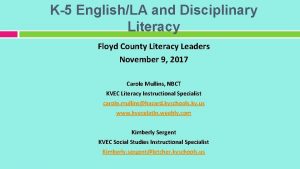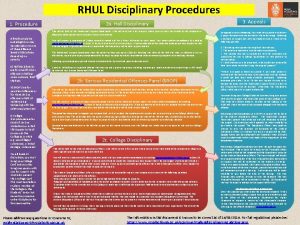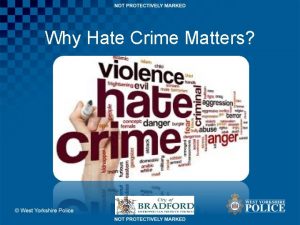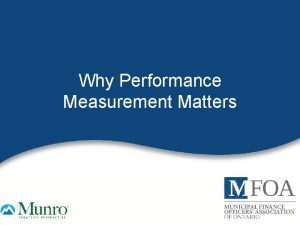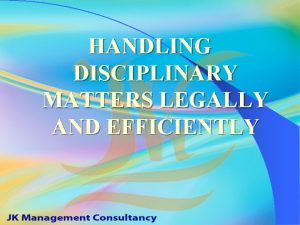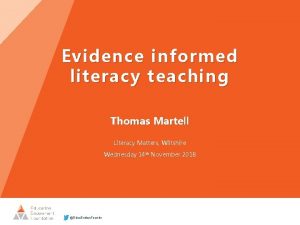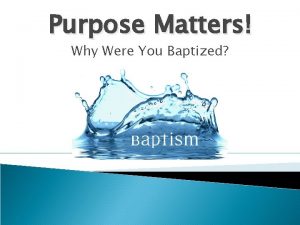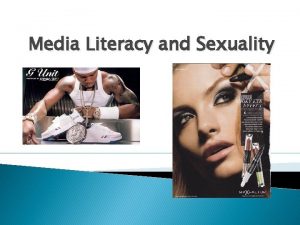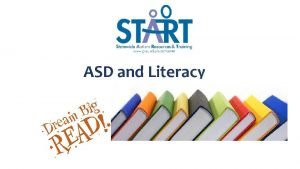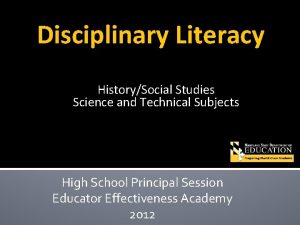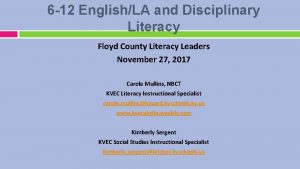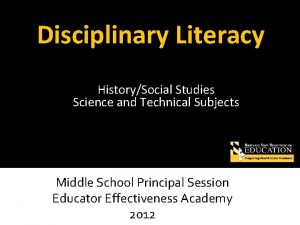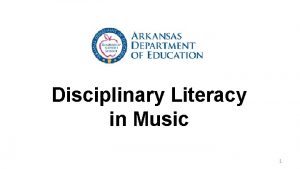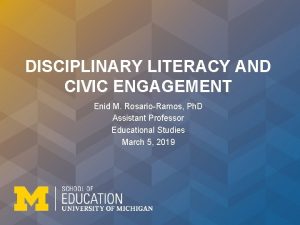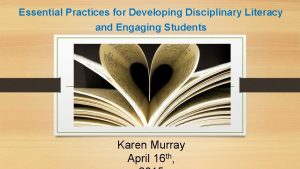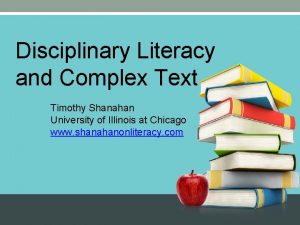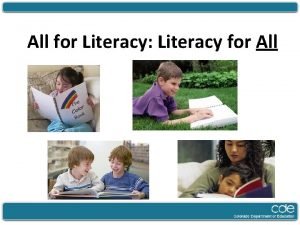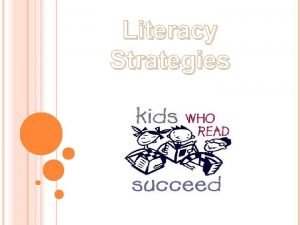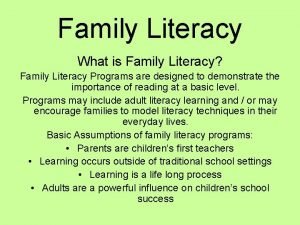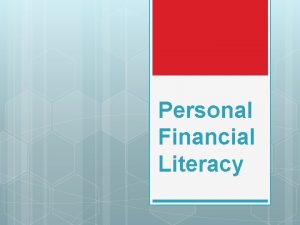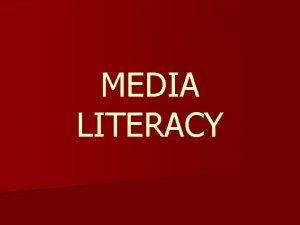Disciplinary Literacy Why it Matters and What We

















































- Slides: 49

Disciplinary Literacy: Why it Matters and What We Should Do About It Elizabeth Birr Moje National Writing Project Conference What’s Next: Possibilities for Literacy and Content Area Learning March 6, 2010

. . . Or. . . HELPING YOUTH NAVIGATE FROM EVERYDAY TO DISCIPLINARY LITERACY PRACTICES

A Prior Question WHAT IS DISCIPLINARY LITERACY?

What is Disciplinary Literacy? Disciplinary literacy perspectives argue that the tools of knowledge production and critique, whether rooted in the disciplines or in everyday life, should be uncovered, taught, and practiced. n Disciplines v. subject areas n

Discipline-Specific Literacy Teaching Practices/Strategies n How do members of the discipline use language on a daily basis? n What kinds of texts do they turn to or produce as part of their work? How are interactions with members of the discipline shaped (or governed by) texts? n n Who are the primary audiences for written work in your discipline?

Discipline-Specific Literacy Teaching Practices/Strategies n What are the standards for warrant demanded by those audiences? n Are there words or phrases that are demanded by or taboo in your discipline? n Are there writing styles that are demanded by or taboo in your discipline? n What is unique about your discipline in terms of reading, writing, speaking, and listening?

HIST PRAC For example, historians: MATH PRAC For example, mathematicians: • Frame historical problems • Ask “Natural Questions” in a given mathematical context • Locate and use residues/evidence from past • Explore and experiment with the context • Analyze and use evidence through interconnected • Represent the context and examine the representation practices of "sourcing, corroborating and contextualizing“ • Look for organizing Structure or Pattern • Determine significance of evidence and events • Consult with colleagues orally or in the literature • Look for patterns in welter of facts and events and "colligate" these to create a concept or periodization • Look for Connections as a result of consultation scheme that imposes sense on that welter of events, e. g. "renaissance" is a colligated term • Seek Proofs or disproofs • Periodize and/or use the periodization schemes of others • Follow Opportunities • Read others’ historical accounts • Write finished exposition of a proof • Produce historical accounts • Analyze Proofs (proof analysis) • Present/publish historical accounts • Present/publish proofs (adapted from R. B. Bain, 2007) • Use appropriate conventions to produce Aesthetically pleasing results (Adapted from H. Bass, 2007)

Question 1 WHY DISCIPLINARY LITERACY MATTERS?

Why Disciplinary Literacy? n Disciplinary slicing of middle school, high school, and university into subject-areas leads to: n Masking of the role that disciplinary practices play in knowledge production n Reification of disciplinary differences n Challenges to coherence for the learner

Access and Opportunity Explicit attention to navigation across multiple discourse communities provides greater access to more young people n In the service of enhancing subject-matter learning (i. e. , to develop deep subjectmatter proficiency) n Builds critical literacy skills for an educated citizenry n

n What is the relationship between disciplinary and generic literacy? Key “Generic” Literacy Skills/Strategies Predicting n Previewing n Questioning n Monitoring n Visualizing n Summarizing n n Most “strategy instruction” attempts to develop these strategies/skills in readers

Discipline-Specific Literacy Teaching Practices/Strategies n Previewing like a historian n n Who is the author? When was this written? What is the context? Previewing like a biologist n n n What is the problem/phenomenon I’m studying? What do I know about this phenomenon? What do I predict/hypothesize about the phenomenon?

History Previewing Example: A Nation of Immigrants n If I told you to that we were reading a chapter from the book, A Nation of Immigrants, what do you expect it would be about? n If I told you that the book was written in 1961, how would that change your predictions? n If I told you that the author was John F. Kennedy, how would that change your predictions?

Now it’s your turn. . . n Previewing like a mathematician? ? ? n n Previewing like a literary theorist or textual critic? ? ? n

Differences across Content Areas: The Persuasive Essay Letter to the Editor Essay or Poem Social Science for English Class Essay Personal opinion or personal experience; may include argumentation; clear stance; language used to indicate personal opinion Personal opinion or experiences AND logical reasoning or illustrative imagery; language used to argue a point or to convey images and experiences Distanced stance, evidence to support stance, logical reasoning to tie evidence to claim; language used to convey distance and objectivity

Question 2 WHAT TO DO ABOUT DISCIPLINARY LITERACY?

The Work to Be Done Disciplinary Reading n Disciplinary Writing n

Disciplinary Reading like an X n Drawing from and developing “necessary knowledge” n Talking about texts n Synthesizing across texts (or “coming back around”) n Teachers taking on texts n

Drawing from and Developing. . . NECESSARY KNOWLEDGE

Foreign-Born Residents by Country of Origin, 1890 -1920 Country/Region 1890 1910 1920 Great Britain 1, 251, 402 1, 221, 283 1, 135, 489 Ireland 1, 871, 509 1, 352, 251 1, 037, 234 Germany 2, 784, 894 2, 311, 237 1, 686, 108 Italy 1, 887 1, 343, 125 1, 610, 113 Romania NA 937, 884 1, 139, 979 Poland 48, 557 65, 923 102, 823

Immigration Statistics, 1920 -1926 Country of Origin Year Total Entering U. S. Great Britain Eastern Europe Italy 1920 1921 1922 1923 1924 1925 430, 001 805, 228 309, 556 522, 919 706, 896 294, 314 38, 471 51, 142 25, 153 45, 759 59, 490 27, 172 3, 913 32, 793 12, 244 16, 082 13, 173 1, 566 95, 145 222, 260 40, 319 46, 674 56, 246 6, 203 304, 488 25, 528 1, 596 8, 253


Emphasis on TEXT TALKING ABOUT TEXTS

Analyzing the texts of instruction TAKING ON TEXTS

Text Analysis of Nature of the Text: n Structure and tone of this text? n n n n n Syntactic (i. e. , sentence structure, organization) complexity Semantic complexity Cohesion Organization and flow of ideas Density of ideas Key ideas or concepts Key words or technical terms Density of vocabulary Texts within text? Role of images, charts, or graphs Coh-Metrix (Graesser & Mc. Namara)

Text Analysis of Relationship between Text and Reader: n n Assumed knowledge Challenges to an adult reader with relatively deep knowledge of this subject Challenges to adolescent readers of this text Necessary scaffolding n n Scaffolding necessary for STRUGGLING readers? Cultural, racial/ethnic, or gendered connections

Text Analysis Analyzing and Planning for Relationships Across Texts: n How would you select other texts to accompany this one? n What connections might you imagine students making across texts? n What connections would you try to help students see across the texts?

What do you need to address in the text and with your students? n Vocabulary? n Conceptual defining n n n Simple defining! Text Structure? n n n Vocabulary concept cards Concept of Definition maps Semantic Feature Analysis Morphological analysis Text structuring strategies Graphic or relational organizing Prior Knowledge? n n Brainstorming Previewing n n n Predicting n n n Preview Guides Advance Organizers POE Anticipation/Reaction Guides Visualizing Lack of coherence? n n n Distinguishing n n n Purpose setting Graphic organizers Comprehension monitoring Notetaking Disciplinary reading strategies? n n n Problem framing Evaluating data warrant Critiquing Synthesizing Applying to investigations or activities

Helping youth read across texts SYNTHESIZING ACROSS TEXTS

Synthesis Journals Primary Source 1 Primary Source 2 Analysis across texts (i. e. , a history) Primary Source 3 Primary Source 4

Summarizing From and Synthesizing Across Texts: Questions Into Paragraphs Driving Question: What affects the quality of air in my community? Learning Set Question: Is material X a pollutant? Sub-Questions Source 1 Source 2 Source 3 SUMMARY 1. What are the sources of this material? 2. What are the effects of this material in the air? 3. How much of this material is typically found in air? SUMMARY: Adapted from: Mc. Laughlin, E. M. (1986). Qu. IP: A writing strategy to improve comprehension of expository structure. The Reading Teacher.

Disciplinary Writing Exposure to and opportunities to write multiple genres and registers n Learning to write the valued genres and register of the discipline. . . really well n

Exposure to Writing . . . OPPORTUNITIES TO WRITE

Student writing in English class Detroit Motor city of the world Automaker and designer A player of cars and casinos A city of violence They tell me your the #1 murder city For I have seen your people and streets. They tell me you are feared and violent And I have seen the results of that with My friends who have passed away. For the people who want to show me the Good side, I’ll show them my reality. The view that only people who live here see and hear. Gang violence, gun shots, drug dealing, rappists Prostitutes, crackheads, bumps, thieves, burn houses, And dirty streets. All of this hides under those beautiful buildings In Downtown. Under the unknown places of the camera hides This terrible everyday dilema we have to go through. Underneath the streets of Detroit hides its people And underneath those people Their solidarity toward society.

Student writing in Social Studies I think middle school students should be required to participate in a community service program because it make them more responsible and teaches them what work realy is. Another reason I think this is because it will help them to be successful and not to die as a teen gang member. Some people have thrown away their lives in gangs this community service program will help prevent that by keeping students away from gangs and away from drugs. The Core Democratic Value that I choose is Common good, I chose this value because it states that we should protect and provide safty for our community as well as for anyone who lives here. Also because the community service program reduces the gang killings and increases the safty around us. Community servics are when students help around their community and to help older neighbors cut the lawn, rake the leafs, or shovel the snow. I have learned that gangs are no good they bring nothing but trouble. All gangs are just about which gang is better the only things they do are fight, steal and cause trouble. Here in Detroit there have been alot of teens being killed because they were involved in gangs.

Valued Genres and Registers LEARNING TO WRITE WELL


Scientific Explanation Writing: An Iterative Practice Examination of explanations written by others n Classroom-based, whole-group generation of rubric using models (i. e. , comes from the students; see next slide) n Engagement in scientific investigations n Writing to explain one’s own investigations n Peer review (e. g. , poster displays, museum walks) n Revision of explanations n New investigations, new explanations, more peer review n

Dilemmas of Literacy Instruction. . IN AN AGE OF ACCOUNTABILITY

Dilemmas of Instruction Writing to a rubric (i. e. , “rules”) n Writing to a problematic rubric n

State Social Studies Writing Rubric State a claim. n Use at least one piece of data from the data provided. n Use a core democratic value to support your argument. n Use at least one idea or principle from one of the social studies (economics, history, civics, etc. ) to support your argument. n

Dilemmas of Instruction Writing mixed genres n Writing “objective” pieces about highly personal or social issues n

To Address the Dilemmas. . . TEACHING PRACTICES

Teaching Practices: Task Analysis n What does the task assume about youth and/or ask them to do as thinkers? n What do youth need to know to meet the task demands? n What kind of text does the task youth to produce? n What do we need to do instructionally to scaffold young people’s thinking before they even begin to write?

A Few More Teaching Practices Writing multiple versions n Teaching students to “go to” or abstract the larger issue n Explicitly critiquing the rubric with and for students n

The Dangers of. . . DISCIPLINARY LITERACY

Reifying Practices

HIST PRAC For example, historians: MATH PRAC For example, mathematicians: • Frame historical problems • Ask “Natural Questions” in a given mathematical context • Locate and use residues/evidence from past • Explore and experiment with the context • Analyze and use evidence through interconnected practices • Represent the context and examine the representation of "sourcing, corroborating and contextualizing“ • Look for organizing Structure or Pattern • Determine significance of evidence and events • Consult with colleagues orally or in the literature • Look for patterns in welter of facts and events and "colligate" these to create a concept or periodization scheme • Look for Connections as a result of consultation that imposes sense on that welter of events, e. g. "renaissance" is a colligated term • Seek Proofs or disproofs • Periodize and/or use the periodization schemes of others • Follow Opportunities • Read others’ historical accounts • Write finished exposition of a proof • Produce historical accounts • Analyze Proofs (proof analysis) • Present/publish historical accounts • Present/publish proofs (adapted from R. B. Bain, 2007) • Use appropriate conventions to produce Aesthetically pleasing results (Adapted from H. Bass, 2007)

For more information. . . www. umich. edu/~moje
 Disciplinary literacy in physical education
Disciplinary literacy in physical education Andreas carlsson bye bye bye
Andreas carlsson bye bye bye Reflexivity definition
Reflexivity definition Brianmac poms
Brianmac poms Disciplinary knowledge
Disciplinary knowledge Disciplinary curriculum
Disciplinary curriculum Kentucky aprn prescriptive authority
Kentucky aprn prescriptive authority Frisk disciplinary
Frisk disciplinary University of texas at arlington library
University of texas at arlington library Media literacy vs information literacy
Media literacy vs information literacy Media literacy and information literacy venn diagram
Media literacy and information literacy venn diagram What does the term people as media mean
What does the term people as media mean Cyber literacy and digital literacy
Cyber literacy and digital literacy Punctuation is important
Punctuation is important Why productivity matters
Why productivity matters Why data quality matters
Why data quality matters Why was every child matters scrapped
Why was every child matters scrapped Why patient experience matters
Why patient experience matters Closing the word gap
Closing the word gap Why theory matters
Why theory matters Why data governance matters
Why data governance matters Why productivity matters
Why productivity matters Why motivation matters
Why motivation matters Masonic civility
Masonic civility Don't ask why why why
Don't ask why why why Orange shirt day quotes
Orange shirt day quotes Ticket pricing simulation answers
Ticket pricing simulation answers Inner wellbeing
Inner wellbeing Mean matter
Mean matter Race matters for juvenile justice
Race matters for juvenile justice Nothing matters question tag
Nothing matters question tag Nationwide yourlife carematters
Nationwide yourlife carematters Money matters topic
Money matters topic Ola miami.performance matters
Ola miami.performance matters Health matters paragraph
Health matters paragraph The purpose of digital graphics
The purpose of digital graphics Food hygiene matters
Food hygiene matters On old olympus towering tops a friendly viking
On old olympus towering tops a friendly viking Talaan ng talahanayan sa pananaliksik
Talaan ng talahanayan sa pananaliksik Don't be a busybody in other people's matters
Don't be a busybody in other people's matters Wolves in cursive
Wolves in cursive Ones choice of words matters
Ones choice of words matters Says means matters
Says means matters Four phase changes
Four phase changes Operations with matrices
Operations with matrices In matters of style swim with the current
In matters of style swim with the current Innovation that matters ibm
Innovation that matters ibm History matters
History matters Trust matters leadership for successful schools
Trust matters leadership for successful schools Word choice matters
Word choice matters
